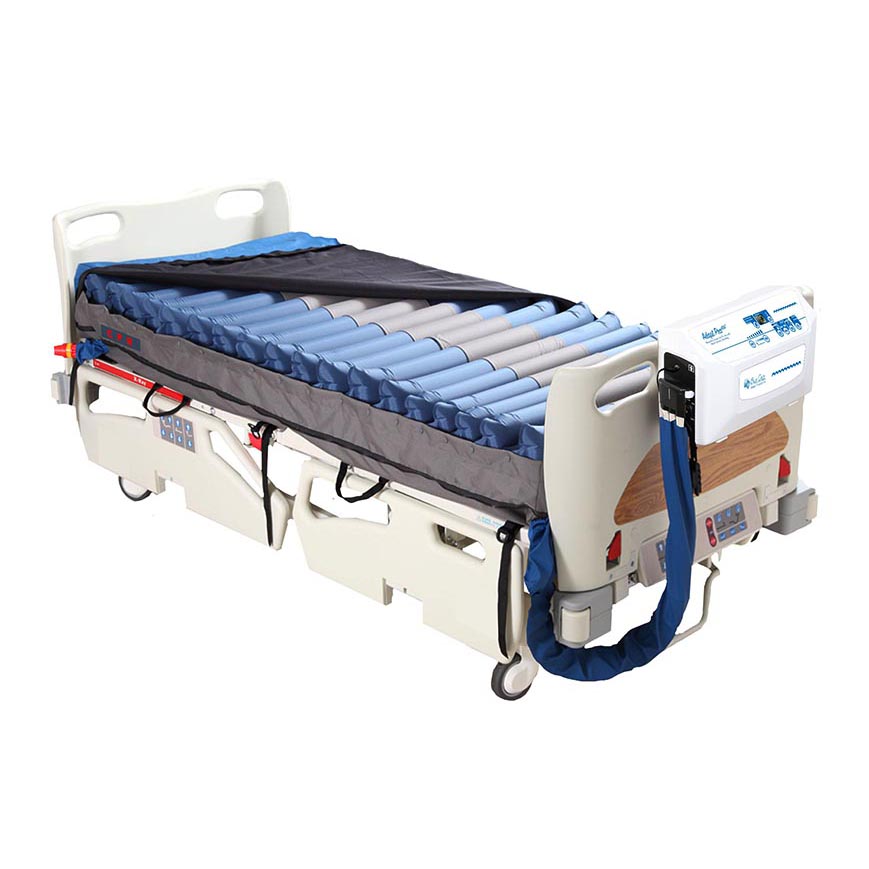Sliding can cause or reopen wounds.
Sliding is most often linked with shearing and friction-type injuries. Skin shear occurs when the skin is pulled in opposite directions as the patient slides, leading the skin to tear. The combination of unrelieved pressure, heat, and moisture contributes to shearing. This puts the patient at a higher risk of developing bed sores.
The body parts most prone to skin shearing and breakdown caused by sliding are:
• Coccyx/Tailbone
• Buttocks
• Sacrum
• Ischial Tuberosity (IT/Sit Down Bones).
If the causes of sliding and skin shear are not corrected, the healing process will be delayed as wounds keep reopening. This will lead to recurring skin breakdown and non-healing wounds. Additionally, the patient will be at a much higher risk of developing a potentially fatal infection, such as MRSA.
Sliding is difficult to prevent because it has many causes. ALL causes must be addressed.
THIS MEANS ADDRESSING
• Patient's position in bed
• Reducing the amount of unnessessary patient repositioning
• Improper use of repositioning devices
• Preventing the patient from sinking into the mattress
• Use of Low shear, low friction mattress cover materials
• Reduce or eliminate anything between the patient and the mattress that can promote sliding.
• Use of a bed frame with proper support
HOSPITAL BED FRAME
Hospital bed frames offer numerous benefits for both the patient and the caregiver. These beds feature independent hinged sections that pivot at fixed points, allowing the frame to raise or lower independently at the head, leg, and foot. However, this range of motion and positioning increases the risk of sliding.
Using a hospital bed frame with proper base support is essential. The support under the mattress can be spring, bar or pan.
Spring frames are prone to sagging under the patient weight especially in the middle when the head of the bed is raised. This can translate to the surface causing a "hole" that the patient sinks into. Not only is this uncomfortable, but improper support can be a contributing factor in sliding.
REPOSITIONING A PATIENT
Should a patient slide down the mattress, Caregivers should be very careful pulling patients up towards the head of the bed. This places the patient at a higher risk of shearing and the caregiver at a higher risk of back injury. Pulling a patient to the head of the bed only for them to slide back down makes the problem much worse by increasing the opportunity for skin shearing. Cycles of raising and lowering the head of the bed without correcting the sliding contributes to skin breakdown.
IMPROPER USE OF SLIDE SHEETS AND INCONTINENCE PADS
These items help with patient repositioning and keep patients dry. Their improper use or overuse can contribute to sliding. Leaving a slide sheet under the patient can make the mattress surface slippery. Furthermore, the use of multiple incontinence pads not only interferes with therapy but can also make the surface of the mattress slippery and cause sliding.
MATTRESS COVER MUST PROVIDE SHEARING AND FRICTION PROTECTION
When purchasing a mattress, make sure that the mattress cover material is low shear/ low friction. This will be help prevent the cover from grabbing the skin and causing a shearing injury. The Vyvex cover materials are best.
TIP TO HELP PREVENT SLIDING IN HOSPITAL BED MATTRESS: RAISE THE PATIENT'S KNEES
Most patients lie on their back in the supine position. Many do not lie flat all the time. When the head of the bed is raised and the patient's legs are flat, there is little to prevent the patient from slide down the mattress toward the footboard.
If possible, raise the patient's knees.
This will help reduce sliding. Raising the patient's ankles is not the same as raising the knee.
PATIENT'S POSITION IN BED
Along with the position of the bed frame, the importance of the patient's position in bed to help prevent sliding can not be overstated. We are all conditioned to place our heads on the pillow at the head of the bed close to the headboard. However, for most people in a hospital bed, this creates space for the patient to slide. Where the patient is placed in the bed is crucial for preventing sliding.
TIP TO HELP PREVENT SLIDING - POSITION THE PATIENT PROPERLY IN THE BED
With the knee raised, position the patient's bottom as close to the raised knee section as possible. This will cradle the patient and will help stop the patient from sliding down the mattress. The patient usually can not slide down past a raised knee section.
HOW TO DETERMINE THE PATIENT'S STARTING POSITION
To determine where on the bed to place the patient: With the knee raised and the bottom cradled, note where the patient's head is in proximity to the head of the bed. Use this position when placing the patient in the bed. Cradling the patient's bottom above the knee section helps reduce sliding.
USE OF REPOSITIONING DEVICES
The use of a slide sheet or the Trendelenberg position found in some bed frames can help reduce the risks. For heavier patients, or more advanced patient repositioning, the use of an air-assisted positioning device such as Air Pod is recommended. These air-assisted devices make repositioning and transfer easier and safer for both the patient and the caregiver.
SINKING INTO A HOSPITAL BED MATTRESS IS A MAJOR FACTOR IN SLIDING AND THE DEVELOPMENT OF SKIN BREAKDOWN
TIP TO HELP PREVENT SINKING - AUTOMATIC FOWLER ADJUSTMENT
Use an alternating pressure mattress with an Automatic Fowler adjustment. Based on the degree of incline at the head of the bed, the mattress compensates for the weight shift by automatically adjusting the pressures in the sacral and bottom bladders to help prevent sinking, sliding, and skin shear. The alternating pressure mattress we recommend with an automatic 2-stage Fowler adjustment is Blue Chip Medical's Adapt Pro Elite.
The Adapt Pro Elite also offers enhanced low air loss built into the low shear, low friction cover to control heat moisture and help prevent skin breakdown. READ MORE ABOUT SINKING
----

ADAPT PRO™ ELITE
Alternating Pressure Enhanced Low Air Loss Mattress System
- Alternating Pressure Therapy
- Enhanced Low Air Loss therapy - Built into the cover
- Automatic 2 Stage Fowler - Prevent sinking and skin shear
- Patient Sensing Technology automatically adjusts mattress
- Sealed bladders for better comfort and immersion
- Precision Comfort Control
- Static Care Mode with fall back
- Available in a variety of widths 36", 42", 48" & Custom
- Fits all hospital beds
- Ultra-quiet Pump
- Supports up to 350 - 800 lbs.
- Optional Pulsation Mode and side bolsters
THE BEST WAY TO HELP PREVENT SLIDING IN A HOSPITAL BED MATTRESS AND THE BED SORES IT LEADS TO, IS TO ADDRESS ALL THE CAUSES OF SLIDING.
The information above is general in nature and is not meant to be utilized to diagnose or treat any condition. Always refer to your physician when seeking medical advice.

About the Author:
Jeff Adise has worked in the wound care industry for over 27 years. He is a product specialist and the developer of innovative therapeutic support surfaces for the treatment and healing of Stages I-IV pressure injuries in home recliners, lift chairs, wheelchairs, and beds. His innovative products are recommended for use by wound care specialists, physicians, and caregivers, across the US. In addition, Jeff is currently collaborating with a team of Doctors and Ph.D. researchers to develop and gain FDA approval for a groundbreaking new topical drug. The promising new drug has been shown to greatly improve the quality and speed of wound healing while reducing infection.To Contact Jeff
E-mail: jeff@comfortsbest.com
Phone: (914) 262-7458


